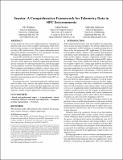Seastar: a comprehensive framework for telemetry data in HPC environments
Abstract
A large number of 2nd generation high-performance computing applications and services rely on adaptive and dynamic architectures and execution strategies to run efficiently,resiliently, and at scale on today’s HPC infrastructures. They require information about applications and their environment to steer and optimize execution. We define this information as telemetry data. Current HPC platforms do not provide the infrastructure,interfaces and conceptual models to collect, store, analyze,and access such data. Today, applications depend on application and platform specific techniques for collecting telemetry data; introducing significant development overheads that inhibit portability and mobility. The development and adoption of adaptive, context-aware strategies is thereby impaired. To facilitate 2nd generation applications,more efficient application development, and swift adoption of adaptive applications in production, a comprehensive framework for telemetry data management must be provided by future HPC systems and services. We introduce Seastar, a conceptual model and a software framework to collect, store, analyze, and exploit streams of telemetry data generated by HPC systems and their applications. We show how Seastar can be integrated with HPC platform architectures and how it enables common application execution strategies.
Citation
Weidner , O , Barker , A D & Atkinson , M 2017 , Seastar: a comprehensive framework for telemetry data in HPC environments . in Proceedings of the 7th International Workshop on Runtime and Operating Systems for Supercomputers ROSS 2017 . , 5 , ACM , New York , International Workshop on Runtime and Operating Systems for Supercomputers , Washington, DC , District of Columbia , United States , 27/06/17 . https://doi.org/10.1145/3095770.3095775 conference
Publication
Proceedings of the 7th International Workshop on Runtime and Operating Systems for Supercomputers ROSS 2017
Type
Conference item
Rights
© 2017, the Author(s). This work has been made available online in accordance with the publisher’s policies. This is the author created, accepted version manuscript following peer review and may differ slightly from the final published version. The final published version of this work is available at dl.acm.org / DOI: 10.1145/3095770.3095775
Items in the St Andrews Research Repository are protected by copyright, with all rights reserved, unless otherwise indicated.

